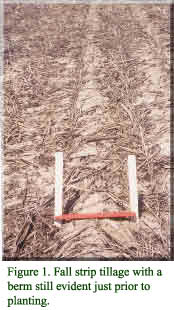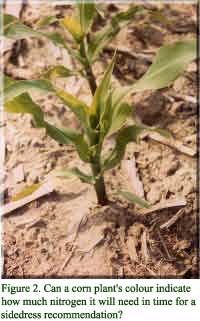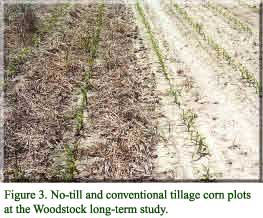
Getting a Plot-Side View
In any year, there are generally
more research and demonstration plots dealing with corn production than most
of us can ever get out to see. This article reviews a few of the research projects
that are underway and attempts to give you a plot-side view of some corn agronomy
issues that will undoubtedly be topics of discussion this winter.
Fall-Strip Tillage and
Fertilizer Banding
 Superior
reduced tillage planting conditions have been the driving force behind strip
tillage expansion. Earlier work at the University of Guelph with the Trans-till
has indicated some real advantages in terms of early season seedbeds often being
drier than no-till systems. However, one of the persistent problems with this
work has been getting a berm built in the fall that is high enough to remain
elevated until planting season, but that is virtually leveled by the planting
operation (see Figure 1). To consistently capitalize on early-planting possibilities
and to enhance planter performance, a good strip tillage system needs to form
a berm in the fall that even after over-winter settling is still 5-10 cm high
at planting time. A series of experiments set up this past fall used fall-strip
tillage to not only loosen and berm the row area, but also to apply P and K.
On the fertility side we are interested in evaluating whether producers can
band P and K in the fall in such a way that the planter will only need to deliver
nitrogen at planting time. This process would simplify and increase efficiencies
in both the planting operation and fall tillage/fertilizer applications. (Researchers/Sponsors:
Dr. Bill Deen, University of Guelph, Monsanto, OSCIA, OMAFRA, Cargill)
Superior
reduced tillage planting conditions have been the driving force behind strip
tillage expansion. Earlier work at the University of Guelph with the Trans-till
has indicated some real advantages in terms of early season seedbeds often being
drier than no-till systems. However, one of the persistent problems with this
work has been getting a berm built in the fall that is high enough to remain
elevated until planting season, but that is virtually leveled by the planting
operation (see Figure 1). To consistently capitalize on early-planting possibilities
and to enhance planter performance, a good strip tillage system needs to form
a berm in the fall that even after over-winter settling is still 5-10 cm high
at planting time. A series of experiments set up this past fall used fall-strip
tillage to not only loosen and berm the row area, but also to apply P and K.
On the fertility side we are interested in evaluating whether producers can
band P and K in the fall in such a way that the planter will only need to deliver
nitrogen at planting time. This process would simplify and increase efficiencies
in both the planting operation and fall tillage/fertilizer applications. (Researchers/Sponsors:
Dr. Bill Deen, University of Guelph, Monsanto, OSCIA, OMAFRA, Cargill)
Corn Plants as N Requirement
Indicators
Can a corn plant tell you how
much nitrogen it needs? Most corn producers have experienced years when whole
or partial corn fields were a pale green, or the firing of lower leaves indicated
the crop did not receive enough nitrogen to optimize yields. Often these signs
become distinct later in the season when it’s too late to do anything to
remedy the situation. Recent research initiatives have established plots to
determine if corn plants can indicate their nitrogen requirements much earlier
- in time to make a recommendation about the amount of nitrogen to sidedress.
Light reflectance meters are placed over the young corn plants to assess their
greeness, to try to correlate this with soil nitrogen and potential fertilizer
requirements. In these plots, some rows of corn received a significant amount
of nitrogen as starter fertilizer, while neighbouring rows received none. Relative
differences in the reflectance of these rows will be used to evaluate N requirements.
(Researchers/Sponsors: Dr. Bill Deen and Jo-Anne Wakem, University of Guelph,
CanAdapt, OCPA, Monsanto, OABA, PPI Canada, IFAO)
Foliar Feeding of Nitrogen
 For
several years, foliar feeding of nitrogen on corn has been evaluated at research
sites at Woodstock and Ottawa. In 1999 (as in previous years), applications
of nitrogen which had a foliar-applied component did not enhance corn yields
over those obtained from similar rates applied only to the soil. The results
from this study show that foliar applications of nitrogen during the vegetative
growth period of the corn crop had no effect on corn yields that could not be
obtained from soil applications. This appears to be related simply to the fact
that very little of this foliar-applied nitrogen actually gets taken up by the
plant. In fact, perhaps foliar applied N may only get taken up effectively once
it washes off the leaves and moves into the soil!
For
several years, foliar feeding of nitrogen on corn has been evaluated at research
sites at Woodstock and Ottawa. In 1999 (as in previous years), applications
of nitrogen which had a foliar-applied component did not enhance corn yields
over those obtained from similar rates applied only to the soil. The results
from this study show that foliar applications of nitrogen during the vegetative
growth period of the corn crop had no effect on corn yields that could not be
obtained from soil applications. This appears to be related simply to the fact
that very little of this foliar-applied nitrogen actually gets taken up by the
plant. In fact, perhaps foliar applied N may only get taken up effectively once
it washes off the leaves and moves into the soil!
One interesting aspect of this project, uncovered by Dr. Baoluo Ma, Agriculture
and Agri-Food Canada, was that when nitrogen was applied directly onto the husks
at the time of silking, nitrogen uptake was considerably higher than when applied
to the corn leaves. Traceable N15 applied directly on the ear at silking time
resulted in 51 per cent of the N accumulating in the grain. We are quite convinced
that foliar applications of nitrogen to corn during the vegetative stage (i.e.,
sixth and twelfth leaf stage) provide no yield benefit. However, in 2000, applications
of nitrogen will be applied directly to the ears at silking time. This practice
will be monitored to determine potentials for yield increases. (Researchers/Sponsors:
Dr. Baoluo Ma and Dr. Lianne Dwyer, AAFC, Innovative Farmers Association of
Ontario, Pioneer Hi-Bred Ltd., and Agriculture and Agri-Food Canada)
Rotational Tillage
 Long-term
tillage plots were established at the Woodstock Research Station in 1995 to
compare:
Long-term
tillage plots were established at the Woodstock Research Station in 1995 to
compare:
• moldboard systems
• chisel plow systems
• no-till systems which have been in no-till for various lengths of time,
and
• rotational tillage systems where no-till is employed two years out of
three, but where chisel plowing is inserted in the third year of the “rotation.”
Results until now appear to indicate that continuous no-till plots do not outyield
“rotational” no-till plots when it comes to growing corn, soys, or
winter wheat. Side-by-side plots of no-till corn following winter
wheat have yielded less than moldboard or chisel systems for corn (see Figure
3) by about eight bu/ac. (Researchers/Sponsors: Dr. Bill Deen, Dr. Tony Vyn,
University of Guelph, OCPA, OMAFRA)
Corn Planter Comparison
For some time, we have been
interested in corn-planting equipment that might be capable of maximizing corn
yields, but that might also lend itself to greater flexibility in terms of row-width
selection, have air-seeding type capacities and efficiencies and be more cost-effective.
To further evaluate the critical factors in corn planting, equipment plots were
established which compare three planter designs:
• finger pick-up
• vacuum metering, and
• bulk air-seeder technology, all operating in both no-till and conventional-till
at planting speeds of both 3.5 and 7.0 MPH. Careful measurements of the plots
will evaluate the relative importance of uniform spacing, uniform emergence
and seed-to-soil contact for the systems employed. (Researchers/Sponsors: Dr.
Bill Deen and Weidong, University of Guelph, OCPA)
Corn Maturity, Frost
and Grain Quality
Delayed corn plantings, concerns
over switching to earlier hybrids, and the potential losses in yield or grain
quality in the event of an early frost have been on many growers’ minds
this past spring. Considerable discussion in the months preceding planting focused
on accurate maturity ratings for hybrids, with some emphasis given to selecting
hybrids based on heat unit requirements to achieve silking, black layer, etc.
In response to these issues, a study was initiated where six hybrids were selected
(three at 2600 CHU and three at 2700 CHU) and planted at the Elora Research
Station on two separate planting dates, May 6 and June 1. These hybrids will
be carefully monitored as to their stages of development. Then, beginning at
the half milk-line stage, and continuing on through to maturity, corn shanks
will be severed at regular intervals to simulate a killing frost. Cobs will
be left to hang/dry in the field. Yield, moistures and test weights will be
determined for each plot in October. Results will add to our understanding of
hybrid maturities, stages of development and the impact of frost events before
a corn crop reaches maturity. (Researchers/sponsors: Dr. Thys Tollenaar, University
of Guelph)
Coming in August
If you would like to stay current with these or other corn research projects
through the summer, visit the OCPA website: www.ontariocorn.org
and in August a new section of the website will concentrate on technology transfer.